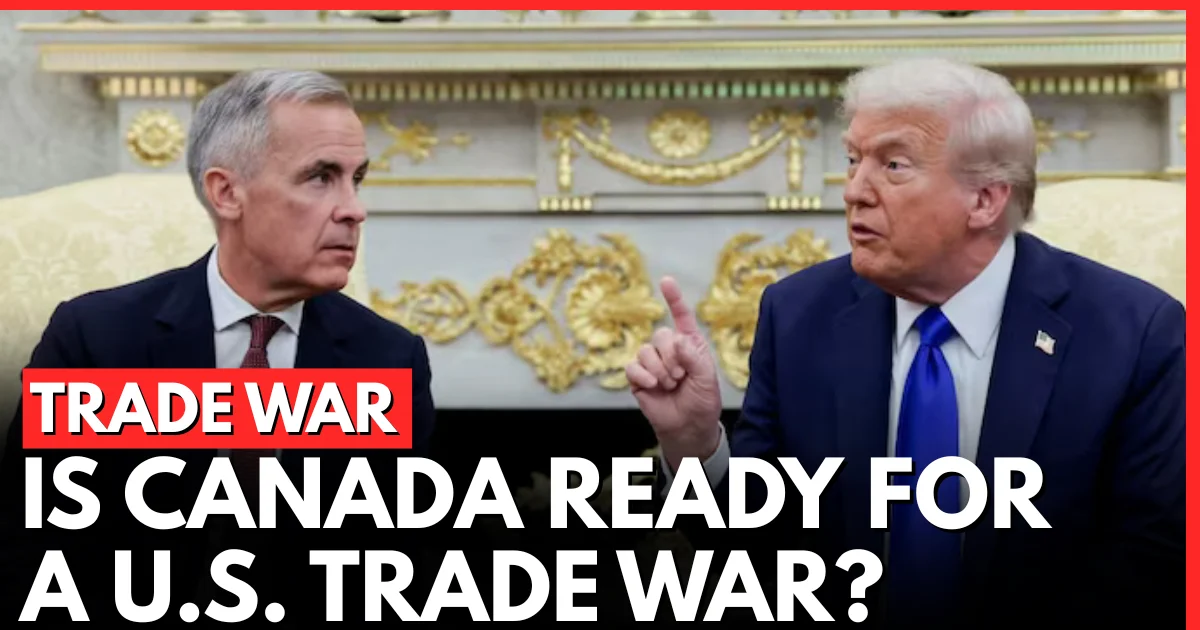Canada faces mounting pressure from US trade tariffs. Can the nation outlast economic tensions with its largest trading partner? Discover the full analysis here.
Table of Contents
Can Canada Actually Wait Out the Prolonged Trade War With America?
The economic standoff between Canada and the United States continues testing one of the world’s most integrated trading relationships. As tariffs mount and tensions simmer, Canadians are asking a crucial question: can their nation simply outlast American trade pressure until conditions change?
The Trade War Reality Canada Faces
Canada finds itself in an uncomfortable economic position. Its largest trading partner has imposed significant tariffs affecting multiple industries crucial to Canadian prosperity.
The numbers paint a challenging picture. Roughly 75% of Canadian exports head to American markets. No other developed nation depends so heavily on a single trading partner.
This dependency creates both vulnerability and leverage. America needs Canadian resources and goods too. But the imbalance remains undeniable.
Understanding What’s Actually at Stake
The Canada-US trade relationship involves staggering amounts of money. Billions of dollars flow across the border daily in both directions.
Key sectors feeling the pressure include:
| Industry | Impact Level |
|---|---|
| Automotive | Severe — Integrated supply chains disrupted |
| Agriculture | High — Farm exports facing new barriers |
| Energy | Significant — Oil and gas trade affected |
| Lumber | Ongoing — Long-standing disputes intensified |
| Manufacturing | Moderate to High — Parts and materials costlier |
Canadian businesses built their operations assuming reliable American market access. Trade uncertainty forces expensive adjustments.
The “Wait It Out” Strategy Explained
Some Canadian policymakers advocate patience. Their reasoning involves several assumptions:
- Political cycles change — American administrations eventually shift
- Economic pain spreads — US businesses will pressure their government
- Negotiation opportunities arise — Deals become possible when timing improves
- Alternative markets develop — Diversification reduces American leverage
This strategy requires Canadians to absorb short-term pain for potential long-term stability. Not everyone agrees the gamble makes sense.
Economic Pressures Building on Canada
Waiting carries real costs that accumulate over time. Canadian households and businesses feel these pressures daily.
Consumer impacts include:
- Higher prices on American goods
- Reduced product variety in stores
- Inflation pressures on household budgets
- Employment uncertainty in affected sectors
Business challenges involve:
- Supply chain disruptions requiring costly adjustments
- Investment decisions delayed amid uncertainty
- Competitive disadvantages against non-tariffed rivals
- Cash flow pressures from increased operating costs
The longer tensions continue, the deeper these impacts penetrate the Canadian economy.
Does Canada Have Enough Economic Cushion?
Canada entered this trade conflict with certain advantages. The nation maintains relatively strong economic fundamentals compared to many peers.
Strengths supporting Canadian resilience:
- Diverse resource base — Energy, minerals, agriculture provide stability
- Educated workforce — Human capital attracts investment
- Stable institutions — Banks and government maintain credibility
- Healthcare system — Reduces some household financial pressures
- International relationships — Trade deals with Europe and Pacific nations exist
However, advantages only stretch so far. Canada cannot indefinitely absorb the costs of restricted American market access.
American Businesses Feel Pain Too
Trade wars create mutual damage. American companies relying on Canadian inputs face their own challenges.
Industries experiencing disruption include:
- Auto manufacturers — Parts cross the border multiple times during production
- Construction firms — Canadian lumber affects housing costs
- Energy companies — Integrated pipeline networks span both nations
- Retail businesses — Supply chains include Canadian products
Some American business groups have lobbied against tariffs on Canadian goods. They argue the policies harm their own competitiveness.
This pressure could eventually influence American trade policy. But timing remains uncertain.
Political Dimensions Complicate Everything
Trade policy doesn’t exist in a vacuum. Political considerations on both sides shape decision-making in ways economics alone cannot explain.
American political factors:
- Domestic manufacturing job promises to voters
- Tough-on-trade messaging appeals to certain constituencies
- Congressional dynamics affect negotiating flexibility
- Election cycles create windows for policy shifts
Canadian political factors:
- National pride resists appearing to capitulate
- Provincial interests sometimes conflict with federal strategy
- Opposition parties criticize whatever approach government takes
- Public opinion constrains negotiating options
Politicians in both nations face domestic audiences limiting their flexibility. This complicates diplomatic solutions.
Alternative Markets: A Realistic Option?
Canadian trade diversification efforts predate current tensions. The nation has pursued deals with the European Union, Pacific nations, and others.
However, geography creates stubborn realities:
| Market | Challenge |
|---|---|
| European Union | Distance increases shipping costs significantly |
| Asia-Pacific | Time zones and logistics complicate relationships |
| Mexico | Already integrated via USMCA with some limitations |
| United Kingdom | Post-Brexit deals still developing |
Diversification helps at the margins. But replacing the American market entirely remains practically impossible for most Canadian industries.
What Economic Experts Are Saying
Analysts offer varying assessments of Canada’s waiting strategy viability.
Optimistic perspectives suggest:
- Canadian fundamentals remain solid enough to endure
- American policy shifts could happen sooner than expected
- Negotiated solutions become likelier as pain accumulates
- Historical patterns show trade tensions eventually ease
Pessimistic perspectives warn:
- Structural economic damage occurs during prolonged disputes
- Investment diverts permanently to more stable jurisdictions
- Canadian businesses lose market share that never returns
- Political relationships suffer lasting damage
The truth likely involves elements from both camps. Canada can probably survive, but not without meaningful costs.
Lessons From Past Trade Disputes
History offers some guidance for understanding current tensions. Canada and America have clashed over trade before.
Previous disputes eventually found resolution through:
- Bilateral negotiation processes
- World Trade Organization rulings
- Political leadership changes
- Industry-specific compromises
However, current tensions feel different to many observers. The scope and intensity exceed typical trade friction. Whether historical patterns apply remains genuinely uncertain.
The Path Forward for Canada
Canadian leaders face no perfect options. Every strategy involves tradeoffs and risks.
Potential approaches include:
- Continued patience — Absorb costs while awaiting changed circumstances
- Aggressive retaliation — Match American tariffs dollar for dollar
- Negotiated concessions — Offer compromises seeking relief
- International coalition building — Unite with other affected nations
- Domestic support programs — Help affected industries and workers survive
Most likely, Canada will pursue some combination of these approaches. Pure strategies rarely survive contact with complex realities.
FAQs
How dependent is Canada on trade with the United States?
Canada relies heavily on American markets, with approximately 75% of Canadian exports destined for the United States. This makes the US by far Canada’s most important trading partner, creating significant vulnerability during trade disputes but also mutual economic interdependence.
What Canadian industries are most affected by US tariffs?
The automotive sector, agriculture, energy, lumber, and manufacturing face the greatest impacts. These industries built extensive cross-border supply chains and depend heavily on American customers. Tariffs disrupt established business models and increase costs throughout production processes.
Can Canada find alternative markets to replace American trade?
While Canada has pursued trade agreements with Europe, Asia-Pacific nations, and others, completely replacing American market access remains practically impossible. Geographic proximity, integrated supply chains, and sheer market size make the United States irreplaceable as Canada’s primary trading partner.
How long could the Canada-US trade war potentially last?
Duration depends on political factors in both nations. Trade tensions could ease with policy changes, election outcomes, or negotiated settlements. However, some disputes have persisted for years or even decades. No clear timeline exists for current tensions.
What happens to prices for American consumers during the trade war?
American consumers often face higher prices on goods containing Canadian inputs. Construction materials, automobiles, energy products, and various consumer goods may cost more. Trade wars typically increase prices for consumers in both countries involved in the dispute.
Conclusion
Canada’s ability to outlast current trade tensions with America remains genuinely uncertain. The nation possesses economic strengths but faces undeniable vulnerabilities tied to its dependence on American markets.
Patience carries costs that accumulate daily. Yet alternatives involve their own risks and sacrifices.
Ultimately, resolution will likely require political will on both sides of the border. Until then, Canadians face difficult economic realities with no easy escape.
Follow our coverage for continuing updates on North American trade relations. Share your perspective on Canada’s strategy in the comments below.

